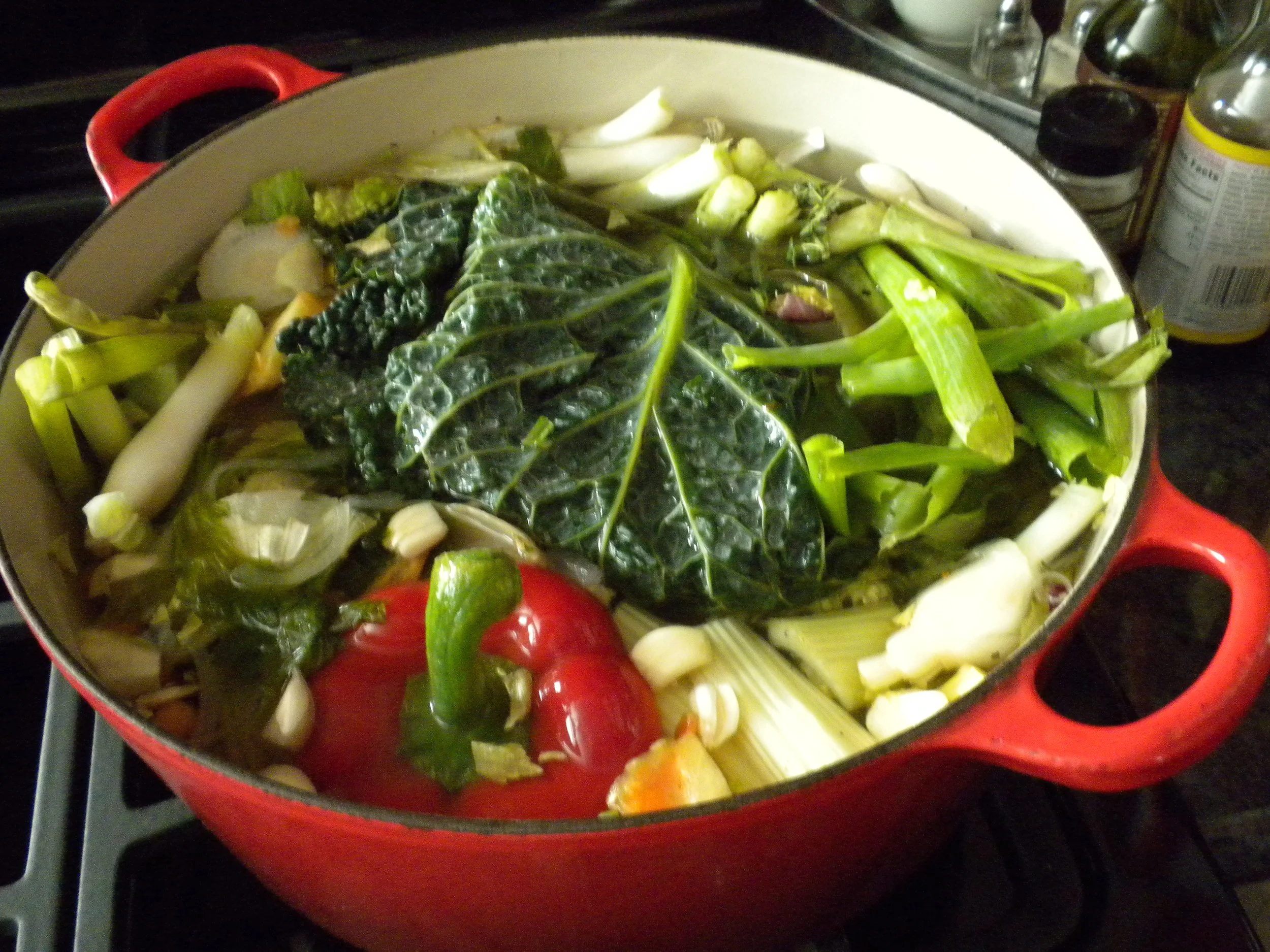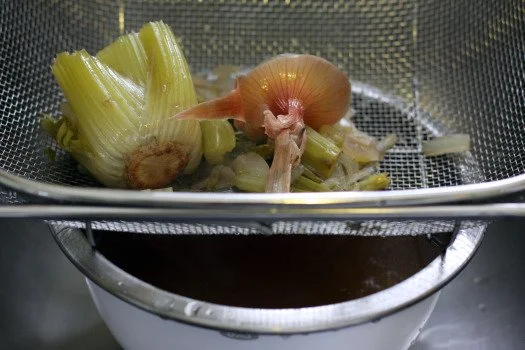How To Start Making Your Own Broth From Scratch
Are you tired of throwing away food scraps in the trash? Is composting not a viable option for you right now? Whether you’re looking for a way to reduce your waste or want to be a more eco-friendly cook, making your own broth at home is an easy, fun, and delicious way to give your vegetable scraps a second life.
Although composting is the best all-around strategy for keeping your food scraps out of the landfill, it’s not always an option, nor is it the only option. Maybe you live in a city that doesn’t offer green waste recycling or you don’t have space to compost your own scraps at home.
Regardless of your composting status, you can make delicious and healthy broth from a variety of food scraps that would otherwise end up in the landfill or the compost. In this article I not only share the benefits of making your own broth but also the basic steps to start making it today!
Vegetable trimmings, herbs, and spices make great ingredients for homemade broth.
Where does food waste go?
Food scraps are a general term for the green waste that comes out of the kitchen. This often includes vegetable peelings, meat or fish bones, inedible parts of various fruits and vegetables, and even leftovers. All food scraps are biodegradable and compostable, yet most still end up in the landfill where they aren’t able to decompose properly.
Food waste is an often-times overlooked environmental issue. An estimated 30-40% of the food supply ends up in the landfill, where it rots (anaerobic decomposition) and releases methane, an extremely potent greenhouse gas (26 times more potent than carbon dioxide!). By contrast, when food waste is allowed to decompose aerobically such as through composting, methane is not released.
We know that reducing food waste alone won’t save all of our environmental concerns, but the more we can do as a society to reduce our collective footprint and live more sustainably, the better.
What do you do with food scraps at home?
Do you throw them in the trash, compost them (either at home or through a local program), feed them to animals, or something else entirely? There are many ways to repurpose food scraps instead of letting them rot in your trash.
Composting is arguably one of the best ways to reduce your food waste at home. But whether you already compost or not, you can give your unwanted food scraps a second chance by making your own broth from scratch.
What is broth?
Broth, or stock, is a flavorful, healthy liquid that is used in cooking. You can use broth to make soups and sauces or even to sauté without oil! You can learn more about the “no-oil” way of cooking here.
You can find many types of broth in the grocery store, including vegetable, chicken, beef, and bone broth. Often the broth you can buy in the store is high in salt and made from low quality ingredients.
Given how easy it is to make broth, why not give it a try?
What do I need to make broth?
Luckily, you only need a few things to start making broth at home, most of which you probably already have:
A plastic bag or container (freezer-appropriate for storing scraps)
A large pot (preferably at least four quarts)
Cheesecloth or a mesh strainer
Glass jars or Tupperware
Why do you need a freezer-appropriate vessel? This is so you can save your food scraps over the course of days, weeks, or even months without fear of them going off before you have time to make broth. Freezing food scraps is my favorite way to “save” for broth and give myself flexibility to make it only once I’ve accumulated enough and have some free time.
You’ll need a soup pot to cook the broth, and a strainer of some kind to strain out all the food scraps and herbs to be left with a beautiful liquid broth. You’ll also want some glass jars or Tupperware so you can save the broth in the fridge for later use.
What food scraps can I save for broth?
What ingredients you want to add to your broth is entirely up to you. This is another reason why making your own can be incredibly fun as well as rewarding! You can save various food scraps to make broth, which you can then supplement with fresh and dried ingredients.
Veggie broth
Vegetable broth is easy to make and prepare for. It is also highly versatile and can take on different flavor profiles depending on what kinds of ingredients you use. Keep in mind that what scraps you save depends on what kinds of vegetables you tend to use most!
Some of my personal favorites include: carrot peels, cabbage leaves, garlic or onion skins, tomatoes, leek, and broccoli stems! Be creative, and feel free to experiment. You’ll learn best through experience what works and doesn’t.
Ingredients I recommend adding (which don’t usually count as “scraps”) include various herbs and spices (my favorites being peppercorn, rosemary, bay leaf, and sage), salt, and any fresh vegetables you’d like to add.
Chicken broth
Meat-based broths are also delicious and incredibly easy to start making yourself. Although you can make chicken broth from fresh ingredients, you can also start saving scraps over the course of weeks and freeze them until you have enough to make a pot of broth.
For example, you can save leftover pieces of chicken, chicken bones, and vegetables such as carrots, celery, and onion. You can also add various herbs and spices of your choosing to enhance the flavor.
Beef broth
Much like chicken broth, beef broth can be a highly versatile and flavorful broth to use in cooking. Start by freezing spare pieces of beef or bones that you can cook with any additional veggies, herbs, and spices.
You can experiment and make broth with a mix of meats and veggies. There are no limits!
Bone broth
Bone broth is similar to regular chicken or beef broth, but tends to be more gelatinous because it is usually cooked longer (up to 12 hours as opposed to just 2 hours), and bones are very high in collagen.
In addition to saving bones from the meat that you eat on a regular basis, you can ask your local butcher for cuts of meat that have big pieces of bone perfect for making broth from. As with all the other kinds of broth, make sure to add some vegetables, herbs, and spices to enhance the flavors!
Food scraps to avoid
Making your own broth can be very easy and rewarding, but not all food scraps are created equally. Avoid using highly pigmented food scraps such as purple cabbage and beet, unless you want to end up with an unappetizing-looking broth (trust me, I’ve been there).
This may seem common sense, but avoid anything rotten or moldy. Either compost or toss these scraps instead of putting them in something you’re going to digest eventually. Even though the cooking process kills off bacteria and molds, toxins are often heat-resistant. It’s best to avoid ingesting anything that has gone “off” to avoid weird tastes or getting sick.
Starchy foods such as potatoes and turnips don’t contribute much to broth and are best avoided.
How to make broth: 5 easy and customizable steps
Save choice food scraps in the freezer
Onion tops, carrot skins, and celery ends are some of the best and most flavorful vegetable scraps you can save for broth. Putting these and other food scraps in a airtight bag or container in the freezer ensures they’ll stay fresh until you’re ready to make your broth.
Add frozen scraps to your soup pot, along with any additional fresh or dried ingredients
When you’ve gathered enough food scraps, at least a quart’s worth, it’s time to make some broth! Grab a soup or stock pot and add your frozen scraps, along with any additional fresh or dried ingredients such as black pepper, bay leaves, fresh onion, and more.
Add enough water to cover all of the ingredients
Cover all the ingredients with plenty of water, and bring to a boil.
Cook for at least 50 minutes, up to 2-3 hours on a low simmer
Turn the heat down and leave the pot simmering for at least 50 minutes, but as long as 2-3 hours, depending on how flavorful you want the broth.
Let the broth cool, then strain.
Once your satisfied, turn off the heat and allow the broth mixture to cool slightly. Use a mesh strainer to strain all the ingredients so that all you’re left with is delicious broth.
That’s it! Once strained, you’ll want to either use it immediately or divide it up into smaller containers such as glass jars. You can do this carefully while the broth is still hot, or allow it to cool further first. You can keep broth in your refrigerator to use fresh for at least 1-2 weeks, or freeze for later use. Add to soups or use while sautéing, braising, etc.! Avoid using it if it starts to smell sour or gets moldy.
Have you made your own broth before? Let us know below in the comments!
































